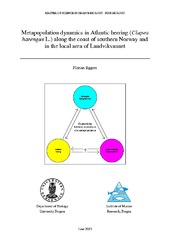| dc.description.abstract | The present thesis provides strong indications for metapopulation dynamics occurring in Atlantic herring (Clupea harengus) along the Norwegian south coast. The evidence stems from analyses of population structure, growth, maturation, spawning time and migration at three different scales. Firstly, comparisons between three oceanic areas (southern and northern North Sea and Skagerrak/Kattegat), two coastal areas (east and west coast of southern Norway) and one local area (Landvikvannet and connected fjords) using historic data from 1970–2012. Secondly, a detailed study of the biological dynamics in the local area over the spawning season 2012. Thirdly, a study of individual migration behavior of tagged herring using acoustic transmitters in the local area over the spawning season 2012. The historical data demonstrated intra- and inter-annual stability in population structure and growth in the southern and northern North Sea. However, in Skagerrak/Kattegat as well as in the coastal and local areas it was highly dynamic. Moreover, the data on maturation and spawning time demonstrated very little overlap between the oceanic areas and the coastal ones, whereas spawning time overlapped clearly between herring diverging phenotypically from the west coast, east coast and in the local area, indicating that mixing of populations during spawning activities potentially could have happened. When this was studied in more details with the intensive biological sampling regime in the local area of Landvik and connected fjords during the spring 2012, data on otolith characteristics, vertebral counts and growth indicated the mixed presence of three different herring types during the spawning period. Herring caught inside Landvikvannet (ILV) had significant lower mean vertebral counts (VS) and lower growth than herring caught outside Landvikvannet in the connected fjords (OLV). Migratory Norwegian spring spawners (NSS) arrived early in the season with peak abundance in mid-March, and they could be identified through otolith characteristics, higher growth and VS (above 57.0) than the other two groups in the local area. While the growth and VS of NSS did not differ significantly within the spawning season, they decreased for ILV and OLV herring, suggesting a mixture of two components changing with time in both areas. The data indicated that one component with relatively fast growth and medium VS between 56.5 and 56.9 appeared early in the season already at the onset of sampling in February and stayed there the whole period. In addition, there was a slow growing component with low VS (below 56.0), similar to historic observations of ILV herring in May, which did not appear early in the season, peaking in May. Despite the different peaks of abundance between the three suggested components, there was a clear overlap in spawning stages. Acoustic telemetry of tagged herring also demonstrated behavioral differences within the local area, which support the conclusion of mixing herring populations in the area. While some herring left the study area immediately, others stayed for a while, migrated up and down in the connected fjords or even entered Landvikvannet. Most migrations took place during the evening and night. Additionally some herring were detected in another acoustic monitoring system 20 km to the north of the study system 2 to 35 days after leaving the area, demonstrating along-coast migrations at different speeds. Finally, relevant historical environmental data series and new environmental data collected during the 2012 spawning season in Landvik and connected fjords were analyzed in relation to the observed herring dynamics at the three different scales. They did not show any significant influence on the intra- and inter-annual variations of biological parameters like growth, VS and maturation, supporting that the observed dynamics rather indicate a mixture of populations changing both historically and over the year. However, the high temperature and low salinity observed in the historic time series from Landvikvannet in May could clearly explain the very low VS observed. Moreover, the observed decrease in VS over the 2012 spawning season in Landvik and connected fjords was significantly related to increasing temperatures, which could indicate a tendency of herring returning to spawn in the same part of the season and in similar environment as their parents. To conclude the combination of data at different scales clearly suggests high dynamics in population structure along the south coast of Norway, and even though differentiation in peak spawning may occur the clear overlap in spawning stages observed in herring diverging phenotypically provides strong indications of regular interbreeding between populations, thereby supporting the metapopulation concept. | en_US |
